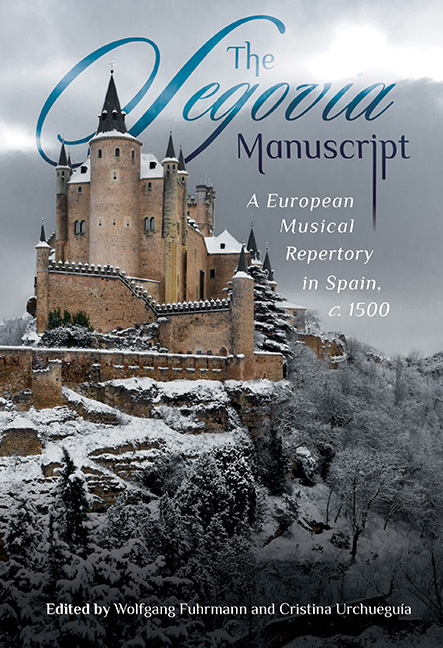Book contents
- Frontmatter
- Contents
- List of Illustrations
- Notes on Contributors
- Abbreviations
- Preambulum: A Source in Segovia
- 1 In Search of Origins: The Afterlife of a Renaissance Manuscript
- 2 New Light on the Segovia Manuscript: Watermarks, Foliation, and Ownership
- 3 Segovia's Repertoire: Attributions and Datings (with Special Reference to Jacob Obrecht)
- 4 What Was Segovia For?
- 5 The Latin Texts of the Segovia Manuscript
- 6 The Segovia Manuscript as Chansonnier
- 7 The Segovia Manuscript: Another Look at the ‘Flemish Hypothesis’
- 8 The Segovia Manuscript: Speculative Notes on the Flemish Connection
- 9 The Written Transmission of Polyphonic Song in Spain c. 1500: The Case of the Segovia Manuscript
- 10 Inventory of Segovia, Archivo Capitular de la Catedral, MS s.s.
- Bibliography
- Index of Compositions
- General Index
- Miscellaneous Endmatter
4 - What Was Segovia For?
Published online by Cambridge University Press: 29 March 2020
- Frontmatter
- Contents
- List of Illustrations
- Notes on Contributors
- Abbreviations
- Preambulum: A Source in Segovia
- 1 In Search of Origins: The Afterlife of a Renaissance Manuscript
- 2 New Light on the Segovia Manuscript: Watermarks, Foliation, and Ownership
- 3 Segovia's Repertoire: Attributions and Datings (with Special Reference to Jacob Obrecht)
- 4 What Was Segovia For?
- 5 The Latin Texts of the Segovia Manuscript
- 6 The Segovia Manuscript as Chansonnier
- 7 The Segovia Manuscript: Another Look at the ‘Flemish Hypothesis’
- 8 The Segovia Manuscript: Speculative Notes on the Flemish Connection
- 9 The Written Transmission of Polyphonic Song in Spain c. 1500: The Case of the Segovia Manuscript
- 10 Inventory of Segovia, Archivo Capitular de la Catedral, MS s.s.
- Bibliography
- Index of Compositions
- General Index
- Miscellaneous Endmatter
Summary
The Segovia manuscript was made by somebody, for somebody, for some purpose. Is it a fool's errand to wonder who and what those were? Very possibly, the answer is yes: there were a lot of musicians, professional and amateur, alive in Spain in the 1490s, and we know useful things about only a very few. So the odds, we should recognize, are much against us. Yet somehow the quest is an irresistible one. Quite apart from its value as a source for music we care about, there is something wonderfully human about Segovia that makes the book itself rise up as a character in the way composers are characters. Its modest appearance and motley (though distinguished) contents seem to speak not of institutions, not of displays of wealth and power, but of the lives and struggles and joys of flesh-and-blood musicians. But who was it for?
At the moment, no one knows. Yet there is one clue that seems particularly significant. Most of Segovia's Spanish repertory is unattributed there, even Urrede's world-famous Nunca fue pena mayor and the half-dozen songs that we know are by Encina, yet there are no fewer than nine attributions to Juan de Anchieta. The obvious, even if not airtight, deduction is that Segovia originated somewhere around Anchieta, and we happen to know that from 1489 until his retirement thirty years later, Anchieta was an employee of one or another of the royal courts of Castile. This in turn has led a few of us, beginning with Emilio Ros-Fabregas in 1992, to notice the court of the best-known musician in the family, Prince Juan, the only son of Fernando and Isabel, as an attractive possibility for the manuscript's original owner. And so I maintained – with suitable circumspection, I hope – for some years. But more recently, in his chapter for the present collection, Ros-Fábregas has shown that Segovia was almost certainly copied just after the prince's death at age 19 in October 1497. I am not quite finished with Prince Juan, but clearly he can no longer be, even hypothetically, our candidate.
- Type
- Chapter
- Information
- The Segovia ManuscriptA European Musical Repertory in Spain, c.1500, pp. 129 - 144Publisher: Boydell & BrewerPrint publication year: 2019



